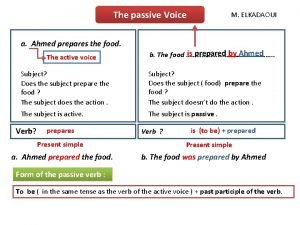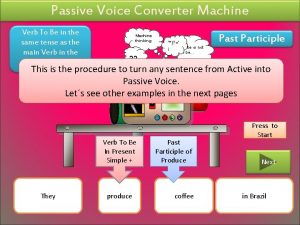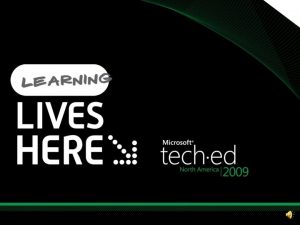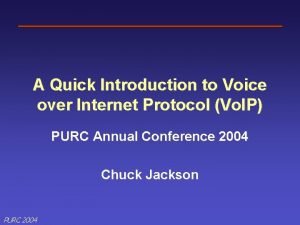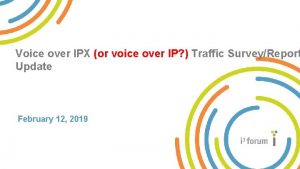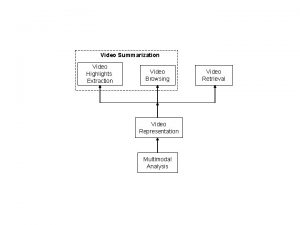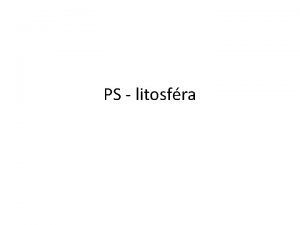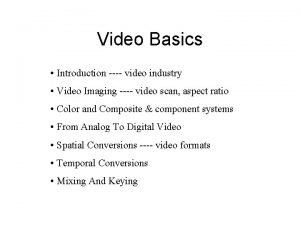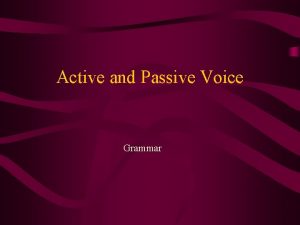Video and Voice over IP performance over a














- Slides: 14

Video and Voice over IP performance over a Satellite link Bob Dixon, Ohio State University/OARnet Prasad Calyam, OARnet Joint Techs Workshops, Columbus, OH, July 21 st, 2004 1

Overview Terminology E-Model Delay, Jitter, Loss H. 323 Beacon Demo Setup Network Performance Bounds H. 323 Beacon Server-to-Server Test Module Conclusion 2

Evaluating Audiovisual Quality Two approaches Subjective Measurements Involve human participants to rate audiovisual quality Can you hear me now? Mean Opinion Score (MOS) Ranking technique (ITU-T P. 800) Not just “Good”! Objective Measurements Automated techniques to rate audiovisual quality Perceptual Assessment of Speech Quality (PESQ) [ITU-T P. 862] “E-Model” [ITU-T G. 107] 3

MOS Rankings 4

E-Model A computational model that uses transmission parameters to predict user perceived voice quality Uses a psycho-acoustic R-scale (0 -100) that can be mapped to MOS rankings (1 -5) E-Model Components R = Ro – Is – Id – Ie + A ≈ 94 – Id –Ie 5

E-Model Components Ro → Effects of noise and loudness Is → Simultaneous Impairment Factor Impairments occurring simultaneously with the speech signal Id → Delay Impairment Factor Impairments that are delayed with respect to the speech signal Ie → Equipment Impairment Factor Impairments caused by transmission equipment A → Advantage Factor Used to compensate for the allowance users make for poor quality in return for the ease of access; e. g. cell phone or satellite phone 6

Understanding Delay… Delay is the amount of time that a packet takes to travel from the sender’s application to reach the receiver’s destination application Caused by codecs, router queuing delays, … One-way delay requirement is stringent for H. 323 Videoconferencing to maintain good interaction between both ends 7

Understanding Jitter… Jitter is the variation in delay of the packets arriving at the receiving end Caused by congestion, insufficient bandwidth, varying packet sizes in the network, out of order packets, … Excessive jitter may cause packet loss in the receiver jitter buffers thus affecting the playback of the audio and video streams 8

Understanding Loss… Packet Loss is the packets discarded deliberately (RED, TTL=0) or non-deliberately by intermediate links, nodes and end-systems along a given transmission path Caused by line properties (Layer 1), full buffers (Layer 3) or late arrivals (at the application) 9

Network Performance Bounds for MOS Grades Delay (Least Problematic) Good (0 ms - 150 ms) Acceptable (150 ms - 300 ms) Poor (> 300 ms) Jitter (Most problematic) Good (0 ms - 20 ms) Acceptable (20 ms - 50 ms) Poor (> 50 ms) Loss Good (0% - 0. 5%) Acceptable (0. 5% - 1. 5%) Poor (> 1. 5%) http: //www. cl. cam. ac. uk/Research/SRG/netos/pam 2004/papers/222. pdf 10

H. 323 Traffic performance characterization Testing Sites More than 500 one-on-one subjective quality assessments from Videoconferencing end-users and corresponding traffic traces were obtained from the Testing!!! 11

H. 323 Beacon http: //www. itecohio. org/beacon An H. 323 application related end-to-end performance troubleshooting tool Can be used to obtain H. 323 -protocol specific evidence and other network information necessary for troubleshooting Latest Version 1. 4 released on Sourceforge. net Developed by OARnet and supported by Internet 2 and Ohio Board of Regents 12

Demo Setup 13

Questions? 14
 Active voice sentence pattern
Active voice sentence pattern Active voice chart
Active voice chart What is passive verb
What is passive verb Videoyandex
Videoyandex Yahoo gravity
Yahoo gravity Yahoo search videos
Yahoo search videos The frame size of a video refers to the video’s
The frame size of a video refers to the video’s Active to passive voice converter
Active to passive voice converter Past continuous tense passive voice
Past continuous tense passive voice Aktiv passiv voice
Aktiv passiv voice Rdp architecture
Rdp architecture Vodafone ipx grx
Vodafone ipx grx Voice over ip project
Voice over ip project Rapid voice over ip
Rapid voice over ip Rapid voice over ip
Rapid voice over ip

